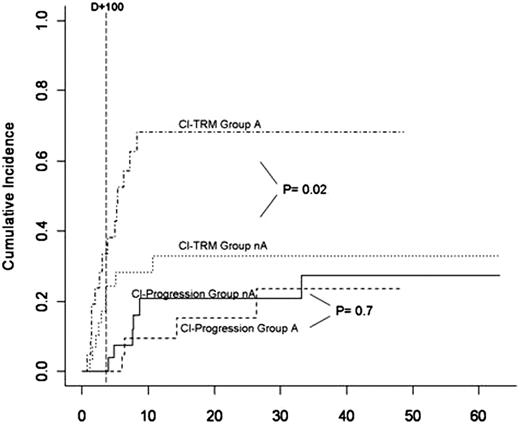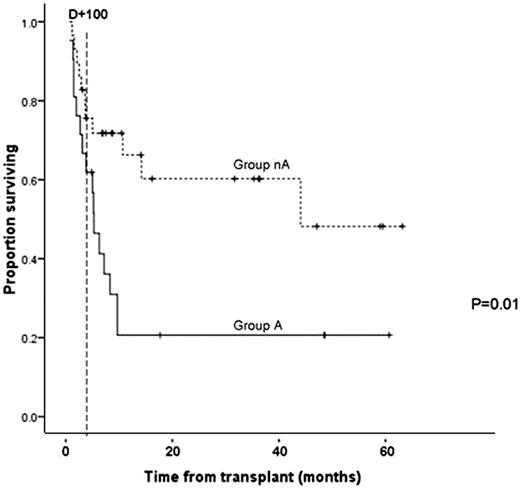Abstract
Abstract 2230
Poster Board II-207
Reduced intensity conditioning (RIC) for allogeneic hematopoietic stem cell (HSC) transplantation is a well established therapy for patients with advanced hematological malignancies who are not suitable candidates for fully myeloablative conditioning. The use of alemtuzumab as part of RIC has been associated with decrease in incidence and severity of graft versus host disease (GVHD), particularly in unrelated donor transplants.
This is a single center, prospective study. Patients with relapsed or refractory hematological malignancies who were not candidates for fully myeloablative conditioning regimens received an non-alemtuzumab (nA) containing RIC regimen or an alemtuzumab-containing regimen (A) based on the use of a matched sibling or an allele-matched unrelated donor, respectively. Patients in the nA group were conditioned with either Fludarabine 30mg/m2/day for 5 days and total body irradiation 200cG or Fludarabine 25mg/m2/day for 5 days and Melphalan 70mg/m2/day for 2 days. Patients in the A group received alemtuzumab 20 mg/m2/day for 2 days, Fludarabine 30mg/m2/day for 5 days and Melphalan 70mg/m2/day for 2 days. All patients received peripheral blood HSC grafts. Prophylaxis against graft versus host disease with cyclosporine and mycophenolate mofetil as well as infectious disease prophylaxis and supportive care guidelines were standard across both groups.
From January 2003 to March 2009, 56 patients were enrolled in the study and 50 patients who actually received a HSCT are the subject of this analysis. Twenty nine patients were in group nA and 21 in group A. Median age of the patients in the entire cohort was 55 years (range 14-65). Eighteen patients had AML, 12 NHL, 8 MDS, 6 CML, 3 CLL and 3 MM. Twenty-three patients were considered to be at high-risk for post transplant relapse (45% of group nA vs. 47% of group A, P= 0.84). All patients in group nA had hematological engraftment while 2 patients in A (9.5%) failed to engraft. Despite the fact that all patients in group A received a transplant from an unrelated donor, the incidence of severe (grades C or D) acute GVHD was significantly higher in group nA (20.7% vs. 0%, P=0.03). Day 100 mortality was similar between the 2 groups (20.7% for nA vs 33.1% for A, P=0.31). Cumulative incidence of progression did not differ between the two groups (P=0.7) while the cumulative incidence of treatment related mortality was higher in group A (P=0.02, Figure 1). Both median overall survival (OS) (44.1 vs. 5.3 months; P=0.01, figure 2) and progression-free survival (PFS) (8.7 vs 5.3 months, P= 0.02) were superior in group nA. Cox regression analysis including conditioning regimen, age and risk of post-transplant relapse showed that conditioning with alemtuzumab was the only variable significantly associated with inferior OS (RR 2.8, P=0.009) and PFS (RR 2.42, P= 0.01). Group A had a higher incidence of late (after Day 100) infectious complications resulting in death (43% vs.10%, p=0.01).
Even though alemtuzumab-based RIC in unrelated HSCT has a protective effect against acute GVHD and risk of D+100 TRM comparable with non-alemtuzumab containing RIC regimens in related donor transplant, its beneficial effect is overcome by excessive late infectious complications.
Fouts:Genzime: Consultancy.
Author notes
Asterisk with author names denotes non-ASH members.



